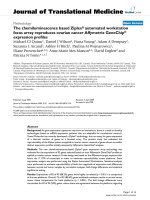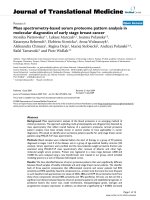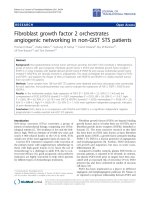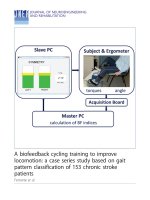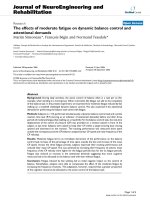báo cáo hóa học:" Neuronal transcription factor Brn-3a(l) is over expressed in high-grade ovarian carcinomas and tumor cells from ascites of patients with advanced-stage ovarian cancer" ppt
Bạn đang xem bản rút gọn của tài liệu. Xem và tải ngay bản đầy đủ của tài liệu tại đây (11.9 MB, 12 trang )
RESEA R C H Open Access
Neuronal transcription factor Brn-3a(l) is over
expressed in high-grade ovarian carcinomas
and tumor cells from ascites of patients with
advanced-stage ovarian cancer
Nuzhat Ahmed
1,2,3,4*
, Ardian Latifi
1,3
, Clyde B Riley
1
, Jock K Findlay
1,2,4
, Michael A Quinn
1,2
Abstract
Objectives: In view of the recent association of Brn-3 transcription factors with neuroblastomas, cervical, breast,
and prostate cancers we examined the expression of Brn-3a(l) in normal ovaries and in different histological grades
of ovarian tumors. The expression of Brn-3a(l) was also evaluated in normal ovarian and cancer cell lines and tumor
cells isolated from the ascites of advanced-stage ovarian cancer patients.
Methods: Normal ovaries, benign, borderline, grades 1, 2 and 3 ovarian tumors were analyzed by
immunohistochemistry for Brn-3a(l) expression. A total of 46 ovarian specimens were included in the study.
Immunofluorescence was used to investigate the expression of Brn-3a in normal ova rian and cancer cell lines. Brn-
3a(l) expression was also evaluated by Western blot in tumor cells isolated from ascites of advanced-stage ovarian
cancer patients and also in ovarian cancer cell lines.
Results: Nearly 12% of normal and benign ovarian tissues and 57% of borderline ovarian tumors were positive for
epithelial Brn-3a(l) expression. Stromal staining was higher and it constituted 40% of normal non-cancerous ovaries
compared to 50 and 86% in benign and borderline tumors. On the other hand, 85-100% of grades 1, 2 & 3 ovarian
tumors demonstrated nuclear and cytoplasmic Brn-3a(l) staining in the epithelium. Stromal staining in grades1, 2
and 3 tumors constituted 71-88% of total staining. Overall, immunoreactive Brn-3a was present in all grades of
ovarian tumors. The extent of epithelial and stromal Brn-3a staining was significantly different between the normal
and histological grades of tumors (epithelial-c
2
= 41.01, df = 20, P = 0.004, stromal- c
2
= 24.66. df = 15, P = 0.05).
The extent of epithelial staining was significantly higher in grades 1 and 2 ovarian tumors compared to normal
ovaries and benign ovarian tumors (p < 0.05). In parallel, stromal staining was significantly higher in grade 3
tumors compared to normal ovaries (p < 0.05). In addition, cytoplasmic and nuclear Brn-3a expression was evident
in ovarian cancer cell lines while no such expression was observed in SV40 antigen immortalized normal ovarian
cell lines.
Conclusion: These data suggest that like other cancers, Brn-3a(l) expression is enhanced in ovarian tumors and its
expression is consistent with its known role in inhibiting apoptosis and enhancing tumorigenesis. Specific targeting
of Brn-3a may provide a useful strategy for regulating multiple tumor related genes involved with ovarian
carcinomas.
* Correspondence:
1
Women’s Cancer Research Centre, Royal Women’s Hospital, 20 Flemington
Road, Parkville, Victoria 3052, Australia
Ahmed et al. Journal of Ovarian Research 2010, 3:17
/>© 2010 Ahmed et al; licensee BioMed Central Ltd. This is a n Open Access article distribute d under the terms of the Creative Commons
Attribution License ( censes/by/2.0), which permits unrestricted use, distribution, and reproductio n in
any medium, provid ed the original wor k i s properly cited.
Introduction
Epithelial ovarian cancer is the fourth major cause of
cancer morbidity and mortalit y in women. In spite of
recent advances, the prognosis f or a woman diagnosed
with advanced-stage ovarian cancer has changed little
over the last thirty years with a five-year survival of only
30% [1,2]. The majority of patients are diagnosed with
Stage 3 or 4 d isease, when the cancer has spread from
the pelvis to the peritoneal cavity and the surrounding
organs [2]. Under these circumstances aggressive local
tumor growth involving invasion and metastasis occurs
which often makes complete surgical removal of the
cancer difficult. The causes of ovarian cancer and fac-
tors that influence the progression of the disease are
only partially understood. A number of genetic abnorm-
alities that h ave diagnostic and prognostic value have
been determined [3,4], and some of the transcriptional
and translational changes that contribute to the develop-
ment and/or progression of the disease have been
described [2], yet the underlying molecular pathways
which initiate and regulate tumor progression still
remain unknown. In contrast to almost all other can-
cers, ovarian cancer typically does not spread through
the b loodstream. Instead, tumor growth is often limited
to the abdominal (peritoneal) cavity, even in advanced
cases. In advanced-stage patients cancer cells from the
surface of the tumors are shed into the abdomen where
they circulate in ascites (tumor fluid) as cellular aggre-
gates and attach at different sites within the abdomen
[5,6]. Debulking surgery followed by six cycles of combi-
nation chemotherapy, consisting o f cisplatin and pacli-
taxel, is successful in initiating remission in 70-80%
patients but it fails to get rid of any residual microscopic
disease. As a consequence, within few months these
patients return with recurrent cancer[1]. In most cases,
patients present themselves with multiple sites of meta-
static disease within the abdomen which are not treata-
ble by secondary surgical removal resulting in bad
prognosis. Hence, better approaches are nee ded not
only to treat the primary cancer but also to inhibit the
growth of recurrent disease. This can be achieved
through a better understanding of the alteration and
expression of transcription factors that regulate cellular
growth, differentiation and apoptosis.
Brn-3 transcription factors (Brn-3a, 3b, 3c) are POU
proteins (pit, Oct, Unc) and belong to the class IV
homeobox family [7,8]. These transcri ption factors were
identified originally in the nervous system [9,10], but are
also expressed in reproductive tract tissues (breast,
ovary, cervix, prostate, testis etc) [11]. They control the
balance betwe en cell proliferation, differentiation and
apoptosis by targeting specific gene promoters either
directly or through interactions with other cofactors
[10,12]. Expression of these transcription factors has
been reported to be altered i n a number of different
cancers. Brn-3a levels are significantly enhanced in cer-
vical cancer [13,14], prostate c ancer [15], neuroendo-
crine tumors [16] and Ewing’s sarcoma [17]. On the
other hand, Brn-3b expression is elevated in neuroblas-
tomas [9,18] a nd in a subset of breast cancers [19,20]
while Brn-3c expression is pres ent in small cell carcino-
mas of the skin with poor prognosis [21].
The Brn-3a protein is encoded by a single gene but its
transcription is regulated by two distinct promoters
[22]. Transcription of this gene from the upstream pro-
moter is followed by splicing to remove an intron
between the first and second exon resulting in the long
form of Brn-3a [Brn-3a(l)]. However, the use of a pro-
moter within the intron downstr eam of t he first exon,
results in the formation of an un-spliced RNA encoding
the short form of Brn-3a [Brn-3a(s)] that lacks the first
84 amino acids [10]. In some cases both forms of the
proteins are produced in different proportion in differ-
ent cells and they have different functional properties
[10]. For example, Brn-3a(l) is over expressed in differ-
entiating primary neurons and neuronal cell lines that
are protected from stimuli t hat would generally induce
apoptosis. This happens through activation and
increased expression of anti-apoptosis genes , including
Bcl-2 [10]. On the other h and, the ability to activate the
promoters of differentiation-associated neurofilaments and
neuronal outgrowth is dependent upon the C-terminal
POU domain of Brn-3a and on both long and short forms
of the molecule [10]. Thus, Brn-3a short and long have
distinct functions in neuronal cells, Brn-3a(l) induces
Bcl-2 expression and protects neurons from apoptosis,
whereas, Brn-3a(s) induces the expression of differentia-
tion-associated genes and induces neuronal differentiation
[10]. Moreover, Brn-3 targ ets many other genes, particu-
larly those with oncogeneic (such as ras and src) and
apoptotic/anti-apoptotic roles (such as p53, Bcl-2, Bcl-x,
Bax, p21, Hsp27) [18,20,23-26]. A recent review hypothe-
sizes an oncogeneic role of Brn-3a by linking it with Bcl-2/
VEGF induction involved in tumor angiogenesis [27],
further implicating the role of this neuronal transc ription
factor in tumor progression.
In view of the evidence for the expression of Brn-3a
transcription factor in non-neuronal cancer cell types of
reproductive origin, we investigated the expression of
Brn-3a(l) in normal ovaries and in different histological
grades of ovarian carcinoma s by immuno histochemistry.
We also investigated the expression of Brn-3a(l) in ascites
tumor cells and ovarian cancer cell lines by Western blot.
ThedifferenceintheexpressionofBrn-3awasalso
evaluated in normal ovarian a nd cancer cell lines by
immunofluorescence. We report distinct expression
Ahmed et al. Journal of Ovarian Research 2010, 3:17
/>Page 2 of 12
pattern of Brn-3a(l) in primary tumors, ascites tumor
cells and ovarian cancer cell lin es consistent with novel
distinct role of this factor in the progression and recur-
rence of this disease.
Methods and materials
Antibodies and reagents
Mouse monoclonal and rabbit polyclonal Brn-3a antibo-
dies were obtained from Santa Cruz Biotechnology Inc
(Santa Cruz, CA, USA) and Millipore (Chemicon, Teme-
cula, USA). The secondary antibodies and immunoper-
oxidase secondary detection system were purchased
from Millipore (Chemicon, Temecula, CA, USA) and
Invitrogen Corporation (Invitrogen, CA, U SA). Western
blotting detection reagents and analysis system were
supplied by Amersham Biosciences (Amersham, UK).
Cell lines
The human epitheli al ovarian cancer lin es OVCA 43 3,
OVCA 429 and SKOV3, obtained from Dr Robert Bast,
MD Anderson Centre, Houston, USA were described
previously [28,29]. Ovarian cancer cell line 2008 was
obtained from Dr Izi Haviv, Peter McCallum Cancer
Centre,Melbourne,Australia.Non-tumorgenicSV40
antigen immortilized human ovarian surface epithelium
derived cell lines (IOSE29 and IOSE80) has been
described previously [30,31], were obtained from Dr
Nelly Auersperg, University of British Columbia,
Canada. These cell lines can be maintained in culture
for several passages. IOSE29 and IOSE80 cell lines are
not tumorigenic in mouse and mimic normal ovarian
cells in culture. Cell lines were grown as monolayers in
25 cm
2
or 75 cm
2
flasks (Nunclon, Roskilde, Denmark)
in complete growth medium consisting of 50% medium
199 (Sigma-Aldrich, Sydney, Australia) and 50%
MCDB131 (Sigma-Aldrich, Sydney, Australia) supple-
mented with 10% (v/v) hea t inactivated FBS and 2 mM
glutamine (Invitrogen Corporation, CA, USA) in the
presence of 37°C with 5% CO
2
.
Tissues
This study was approved by the Research and Human
Ethics Committee (HEC # 09/09) of The Royal
Women’s Hospital, Melbourne, Australia. The subjects
were recruited after the provision of a participant infor-
mation statement and with informed consent. Ovarian
cancer patients with serous, mucinous, endometrioid,
clear cell carcinoma and mixed subtypes were included
in the study. The histopathological diagnosis and tumor
grades were determined independently by staff patholo-
gists. Histological grading was assigned as described by
Silverberg [32]. Non-cancerous ovarian tissues were
obtained from patients undergoing surgery as a result of
suspicious ultrasound images, palpable abdominal
masses and/or a family history of ovarian cancer.
Description of patients who participated in the study is
provided in Additional file 1 (Table 1).
Preparation of tumor cells from ascites of ovarian cancer
patients
100-500 ml of ascites was collected from patients diag-
nosed with advanced-stage serous ovarian carcinomas.
Ascites was centrifuged and the contaminating r ed
blood cells were removed by giving the cell suspension a
hypotonic shock for 1 minute in steril e MilliQ H
2
O.
The remaining cells were re-suspended in growth med-
ium and counted using the Trypan Blue exclusion
method. Initially some lymphocytes and fibroblasts were
present but were easy to d istinguish. Lymphocytes were
small, smooth and perfectly round cel ls. Fibroblasts
were long elongated cells wherea s tumor cells were
large with visible nuclei. In many cases, large multinu-
cleated tumor cells were visible. Tumor cell cultures
were incubated at 37°C in 5% CO
2
in growth medium
containing 50% Dulbecco Modified Eagle’ sMedium
(DMEM) (Sigma-Aldrich, Sydney, Australia) and 50%
MCDB131 (Invitrogen, CA, USA) supplemented with
10% (v/v) heat inactivated FBS and 2 mM glutamine
(Invitrogen CA, USA). After 1-2 weeks, cultured c ells
were screened f or the presence of tumor cells and con-
taminating fibroblasts by the cell surface expression of
fibroblast surface protein (FSP), CA-125 and EpCAM
(Sapphire Bioscience, Melbourne, Australia) using a flow
cytometer (Becton and Dickinson, USA). Initially the
expression of FSP was detec ted in 50 % of the cultures.
Confluent culures were split at 1:2 and after 3-4 pas-
sages the cultures were screened again for FSP, CA-125
and EpCAM. Sustained expression of CA-125 and
EpCAM was observed in 3-4 passage cultures with sig-
nificantly low expression of FSP indicating the over rid-
ing dominance of epithelial tumor cells with very few
contaminating cells expressing FSP.
Immunohistochemistry
Immunohistochemical analysis of ovarian tissues was
performed as described previously [33,34]. Br iefly, paraf-
fin sections were cut at 4 μm thickness, mounted on
silane coated slides and incubated overnight a t 37°C.
Sections were washed with distilled water after two
changes of xylene and three changes of ethanol. Antigen
retrieval was performed using citrate buffer (pH 6.0)
and sections were held in Tris buffered saline (TBS).
Endogenous peroxidase activity was removed using 3%
hydrogen peroxide in methanol. The sections were incu-
bated for 1 h in primary antibody(mousemonoclonal
Brn-3a antibody, Santa Cruz, CA, USA) diluted 1/200 in
1% BSA in Tris buffer (100 mM, pH 7.6) at room tem-
perature. Antibody binding was amplified using biotin
Ahmed et al. Journal of Ovarian Research 2010, 3:17
/>Page 3 of 12
and streptavidin HRP (Chemicon, CA, USA) for 15 min
each and the complex was visualized using diaminoben-
zidine (DAB). Nuclei were lightly stained with Mayer’ s
haematoxylin. Control IgG was used as a negative
control.
Sections were assessed microscopically for positive
DAB staining. Two observers independently evaluated
the immunostaining results. The concordance ratio was
>95%. Four sections were assessed per tissue sample and
the subcellular distribution of staining was determined.
Parallel sections were stained with hematoxylin and
eosin to confirm the pathology diagnosis.
Interpretation of staining results
The staining pattern of Brn-3a was evaluated as follows:
1. Immunoreactive Brn-3a was localized in the cyto-
plasm and/or nucleus of epithelial and stromal cells;
2. The extent of positive staining was deduced using
the following scale: for each specimen, the positive
staining extent was scored in 5 grades, namely, 0
(≤10%), 1 (≥11-25%), 2 (≥26-50%), 3 (≥51-75%), 4 (≥76-
90%) and 5 (≥90~100%). The intensity of staining was
further classified as low, moderate and high according
to the intensity of DAB staining.
Immunofluorescence
Immunofluorescence analysis of Brn-3a was performed
by using the r abbit polyclonal Brn-3a antibody (Chemi-
con, Temecula, USA) as described previously [29].
Mouse monoclonal anti-mouse b-actin (Sigma, Mel-
bourne, Australia) was used as an internal control.
Alexa Fluor® 488 (goat anti-mouse IgG) and Alexa
Fluor® 555 (goat anti-rabbit IgG) (Invitrogen, Melbourne
Australia) were used as secondary antibodies. Images
were visualized and captured by the fluoresce nce micro-
scope (Olympus AX-70, Olympus, Australia), photo-
graphed and analysed with Zeiss AxioCam Axiovision
software (Carl Zeiss Inc., New York, USA).
SDS-PAGE and Western blot analysis
SDS-PAGE and Western blot was performed on cell
lysates as described previously [34]. Mouse monoclonal
Brn-3a antibody (Santa Cruz, CA, USA) was used for
the detection of the 43 kDa Brn-3a. Protein loading was
monitored by stripping the membrane with Restore
Western blot Stripping Buffer (Thermo Scientific, MA,
USA) and re-probing the membrane with b-actin pri-
mary antibody (Sigma-Aldrich, Sydney, Australia).
Statistical analysis
Statistical analysis of the extent of Brn-3a(l) immunos-
taining between normal and tumor groups was deter-
mined by using Chi-squared test using the SPSS
statistical software. In addition, the differences of the
extent of staining between each individual tissue type
(normal and different histological grades of tumors)
were analyzed by non-parametric Kruskal Wallis test
followed by Dunn’s Multiple Comparison post tests. All
data were considered significantly different from each
other at p < 0.05.
Results
Immunohistochemical expression of Brn-3a in ovarian
tissues
MousemonoclonalBrn-3aantibody(SantaCruz,CA,
USA) was used for immunohistochemical analysis. This
antibody was raised against amino acids 1-109 of Brn-3a
of mouse origin and is specific for mouse, rat and
human Brn-3a(l) form. Some ovarian tissue sections dis-
played some degree of background staining in the
stroma possibly due to cross reaction of stromal factors
with the Brn-3a antibody.
Non-cancerous (normal) ovarian tissues
Out of e ight normal ovarian sections examined, seven
displayed no Brn-3a(l) staining on the ovarian surface
epithelial cells (Fig 1a) while one showed moderate
staining (Fig 1b). Weak to moderate stromal staining
was observed in three normal ovaries. Staining in the
stroma was both nuclear and cytoplasmic. Hence, 12%
of non-cancerous normal ovarian tissues displayed
epithelial staining in contrast to 40% stromal staining.
Benign and borderline tumors
Benign tumors exhibited similar epithelial staining as
normal ovaries with six out of seven benign tumors
exhibiting no staining while one demonstrated moderate
nuclear and cytoplasmic staining (11%) (Figs 1c and 1d).
In contrast, the associated stromal tissues of three
benign tumor tissues exhibited some staining confined
to both nucleus and cytoplasm. Hence, 11% of benign
tumors demonstrated epithelial staining compared to
50% of stromal staining.
The pattern of staining in borderline ovarian tumors
varied with three tumors exhibiting no staining with
other three demonstrating weak and one moderate
epithelial staining (Figs 1e and 1f). Weak stromal stain-
ing of five tumors was evident while one showed moder-
ate staining. Both nuclear and cytoplasmic staining was
observed in positive specimens. Overall compared to
normal ovaries both benign and borderline tumors
exhibited denser stromal staining. This was more promi-
nently observed in tumors of mucinuous subtype. In
short, 57% of borderline tumors exhibited weak to mod-
erate Brn-3a(l) staining, whereas 86% of these exhibited
similar stromal staining.
Ahmed et al. Journal of Ovarian Research 2010, 3:17
/>Page 4 of 12
Figure 1 Expression of Brn-3a(l) in normal ovaries, benign and borderline tumors. Archival ovarian tissues were stained by the method
described in the Materials and Methods. (a) Normal ovary, no epithelial or stromal staining; (b) normal ovary, moderate epithelial staining
indicated by a long arrow; (c) benign mucinous tumor, no epithelial or stromal staining; (d) benign serous ovarian tumor, positive for epithelial
(long arrow) and stromal (short arrow) Brn-3a(l) staining; (e) borderline mucinous tumor negative for epithelial and stromal staining and (f)
borderline serous ovarian tumor positive for epithelial (long arrows) and stromal (short arrow) staining. Magnification-400; scale = 50 μm.
Ahmed et al. Journal of Ovarian Research 2010, 3:17
/>Page 5 of 12
Grades 1, 2 and 3 tumors
Grade 1 ovarian tumors e xhibited more epithelial stain-
ing than t heir benign and borderline counterparts (Figs
2a &2b). 85% of grade 1 tumors exhibited weak to mod-
erate Brn-3a(l) staining with six out of seven tumors
demonstrating weak to moderate staining while one
tumor did not show any sta ining at all. Staining of the
epithelial cells was both nuclear and cytoplasmic. Weak
to moderate stromal staining was also evident in 71% of
samples. All grade 2 tumors exhibited epithelial Brn-3a
(l) staining while stromal staining was evident in 87% of
the samples (Fig 2c). 77% percentage of grade 3 patients
demonstrated epithelial Bn-3a(l) staining compared to
88% stromal staining. Staining was confined to both
nucleus and cytoplasm (Figs 2d and 2e). The staining
intensity in both the epitheli um and stroma of grades 1,
2 and 3 tumors was also enhanced.
None of the tissues showed any positive staining wit h
the control IgG (Figs 3a-c).
Statistical analysis
By using Chi-squared test significant differences in the
extent of Brn-3a epithelial as well as stromal immunos-
taining was determined between normal and histological
grades of tumors (c
2
= 41.01, df = 20, P = 0.004, c
2
=
24.66, df = 15, P = 0.05). In parallel, the e xtent of Brn-
3a staining was also significantly different in the epithe-
lium of benign and borderline tumors compared to
grades 1, 2 and 3 tumors (c
2
= 14.33, df = 4, P = 0.006).
To further analyze differences between each individual
tissue and tumor types Kruskal Wallis and Dunn’sMul-
tiple Comparison po st tests were performed. Compared
to normal ovaries (0.13 ± 0.35, mean ± SD) and benign
tumors (0.14 ± 0.38) significantly higher extent of
epithelial Brn-3a(l) staining was observed in grades 1
(2.00 ± 1.29) and 2 tumors (2.13 ± 0.99) (p < 0.05) (Fig
4). In addition, stromal staining in grade 3 tumors (1.67
± 1.00) was also significantly higher compared to normal
ovaries (0.38 ± 0.52) (p < 0.05) (Fig 4).
Brn-3a expression in normal ovarian and cancer cell lines
as well as tumor cells isolated from ascites of advanced-
stage cancer patients
Immunofluorescence analyses
Immunofluorescence study was performed to determine
the differences of Brn-3a expression in SV40 immorta-
lized normal ovarian (IOSE29 and IOSE80) and cancer
cell lines (OVCA433 and 2008) (Figs 5 and 6). As the
Santa Cruz anti-Brn-3a(l) has the same mouse host as
anti-b-actin (used as an internal control), the immuno-
fluorescence experiment was performed with Millipore
anti-rabbit Brn-3a antibody which re cognizes both the
short [Brn-3a(s)] and long forms of Brn-3a [Brn-3a(l)].
No significant Brn-3a expression was detected in
immortalized normal ovarian cell lines (Figs 5a and 5b).
On the other hand, p ositive cytoplasmic and nuclear
Brn-3a staining was evident in both OVCA433 and 2008
ovarian cancer cell lines with 2008 demonstra ting more
staining than OVCA433 cell line (Figs 6a and 6b).
Western blot analyses
In order to determine the isoform expressed by ovarian
cancer and tumor ce lls from ascites of ovarian cancer
patients b oth Santa Cruz and Millipore antibodies were
used. Western blotting was performed on cell lysates
prepared from tumor cells isolated from patient’s ascites
and ovarian cancer ce ll lines OVCA433, OVCA429,
2008 and SKOV3. Santa Cruz anti-mouse Brn-3a anti-
body which recognizes the long form of Brn-3a demon-
strated the expression of Brn-3a (l) (~43 kDa) in ovarian
cancer cell lines and tumor cells isolated from patient’s
ascites (Figs 7a and 7b). The expression of Brn-3a(l) was
relatively higher in OVCA429 and 2008 cells compared
to OVCA433 and SKOV3 cells. This was consistent
with immunofluorescence results which showed rela-
tively higher expression of Brn -3a in 2008 ce lls com-
pared to OVCA433 cell line (Figs 6a and 6b). Western
blotting results using Santa Cruz anti-Brn-3a(l) antibody
also demonstrated strong expression of B rn-3a(l) in the
four ascites tumor samples which varied in expression
with equal protein loading. Variable expression of b-
actin which was used as an internal control was also
demonstrated. In our hands we were unable to produce
any Brn-3a band with Millipore anti-rabbit Brn-3a anti-
body indicating the unsuitability of this antibody for
Western blot studies.
Discussion
Malignant tumors initiate a transcriptional machinery to
crea te a self-sustaining environ ment to b reak the neigh-
boring cell barriers in order to facilitate migration and
colonize to distant sites [35]. This is achieved by the
acquisition, enhancement or alteration of the expression
of transcription factors that initiate the transcriptional
program needed for the metastatic process. These events
are dependent on the ove r and under expression of
molecules generally required for normal cellular func-
tions. The indication that Brn-3a, a member of the Brn-
3 family of type IV POU domain transcription factors is
involved in the etiology of cancer has been demon-
strated previously by the over expression of this tran-
scription factor in CIN3 cervical lesions [13,14],
neuroendocrine tumors [16], Ewing sarcomas [17] and
prostate cancers [15]. Although the molecule is
expressed at low levels in normal cervix and prostatic
epithelium, it i s significantly increased in CIN-3 lesions
and prostate carcinomas. The expression of this tran-
scription factor has been reported previously in normal
ovaries [11] but not in ovarian carcinomas. In this
Ahmed et al. Journal of Ovarian Research 2010, 3:17
/>Page 6 of 12
Figure 2 Expression of Brn-3a(l) in grades 1, 2 and 3 ovarian tumors. (a) Grade 1 mucinuous; (b) grade 1 endometriod; (c) grade 2 serous;
(d) grade 3 serous and (e) grade 3 clear cell carcinoma tumors. Long arrows in each tumor illustrate positive Brn-3a(l) staining of the scattered
epithelium. Short arrows in (d) and (e) indicate scattered stromal staining. Magnification-400; scale = 50 μm.
Ahmed et al. Journal of Ovarian Research 2010, 3:17
/>Page 7 of 12
study, we report enhanced expression of Brn-3a(l) in dif-
ferent histological grades and pathological subtypes of
ovarian carcinomas as well as in the tumor cells isolated
from ascites of ovarian cancer patients a nd in ovarian
cancer cell lines.
Weak to moderate immunoreactivity of Brn-3a(l) was
observed in almost all ovarian tumors studied. On the
other hand, only 12% of normal ovaries had epithelial
Brn-3a(l) immunoreactivity. The stromal staining even
though relatively higher in the extent, constituted 40%
of total staining. It should be noted that normal ovaries
constituted of noncancerous ovarian tissues obtained
from patients who have opted to remove their ovaries as
a result of suspicious ultrasound images, palpable
abdominal masses and/or a family history of ovarian
cancer. Hence, it still remains to be determined if the
observed Brn-3a(l) expression in one ovary is a conse-
quence of genetic and/or clinical conditions of the
patients involved or is a one off phenomenon of normal
un-diseased ovary. This is consistent with an earlier
study which reported weak expression of Brn-3a(l) in
normal ovaries by Western blot [11]. Consistent with
our results on normal ovaries, low expression of Brn-3a
has also been reported in n ormal cervix a nd prostatic
Figure 4 Immunohistochemical expression of Brn-3a(l) in normal, benign, borderline, grade 1, grade 2 and grade 3 ovarian tumors.
Medians are shown as horizontal lines. Significant differences in the extent of epithelial and stromal Brn-3a(l) staining between normal and
grades 1, 2 and 3 tumors are indicated by * (p < 0.01) and ** (p < 0.05).
Figure 3 Negative IgG controls for Brn-3a(l) staining in (a) grade 1 endometrioid (same tumor as in Fig 2b); (b) grade 2 serous (same
tumor as in Fig 2c) and (c) grade 3 serous tumor (same tumor as in Fig 2d). Magnification-400; scale = 50 μm.
Ahmed et al. Journal of Ovarian Research 2010, 3:17
/>Page 8 of 12
Figure 5 Expression and localization of Brn-3a in (a-b) SV40 immortalised normal ovarian cell lines by fluorescent microscopy.The
expression and localization of Brn-3a was evaluated by using rabbit polyclonal Brn-3a antibody by fluorescent microscopy as described in the
Methods and Materials. Cytoplasmic and nuclear staining were visualized using secondary Alexa 590 fluorescent labeled (red) antibody and DAPI
(blue). Anti-mouse b-actin staining (green) followed by Alexa 488 (green) fluorescent labeling was used as an internal control. Magnification-400;
scale = 50 μm.
Figure 6 Expression and localization of Brn-3a in (a-b) ovarian cancer cell lines by fluorescent microscopy. The expression a nd
localization of Brn-3a was evaluated by using rabbit polyclonal Brn-3a antibody by fluorescent microscopy as described in the Methods and
Materials. Cytoplasmic and nuclear staining were visualized using secondary Alexa 590 fluorescent labeled (red) antibody and DAPI (blue). Anti-
mouse b-actin staining (green) followed by Alexa 488 (green) fluorescent labeling was used as an internal control. Magnification-400; scale = 50
μm.
Ahmed et al. Journal of Ovarian Research 2010, 3:17
/>Page 9 of 12
epithelium [14,15]. Weak expression of Brn-3a(l) was
observed in benign ovarian tumors, while borderline
ovarian tumors demonstrated weak to moderate cyto-
plasmic and nuclear expression. On the other hand,
almost all ovarian tumors studied expressed Brn-3a(l)
both in the epithelium as well as in the stroma.
Enhanced expression of Brn-3a(l) in stromal cells of
high grade tumors may contribute to the metastatic
ability of tumors cells as demonstrated by the tumor
growth enhancing effects of cancer associated fibroblasts
[36] and infiltrating macrophages [37]. This is consistent
with the previously described role of Brn-3a in tumori-
genesis, and suggests its functionally active status in reg-
ulating the expression of key genes regulating tumor
metastasis [13,15]. Consistent with the immunohisto-
chemistry results, moderate to high cytoplasmic and
nuclear expression of Brn-3a was observed in ovarian
cancer cell lines. However, no Brn-3a e xpression was
Figure 7 Western blot analysis of Brn-3a(l) expression in (a) ovarian cancer cell lines and (b) tumor cells from a scites of cancer
patients. Cell lysates (25 μg) of (a) ovarian cancer cell lines (OVCA433, OVCA429, SKOV3 and 2008) and (b) tumor cells isolated from the ascites
of patients with advanced-stage ovarian cancer (As2, As4, As9, As11) were prepared and loaded on 10% SDS-PAGE gels as described in the
Methods and Material. Blots were probed with mouse monoclonal Brn-3a(l) antibody, stripped and re-probed with mouse monoclonal b-actin
antibody as an internal protein loaded.
Ahmed et al. Journal of Ovarian Research 2010, 3:17
/>Page 10 of 12
observed in immortalized normal o varian cell lines, sug-
gesting again that Brn-3a in ovarian neoplasms acts as
an oncogene as demonstrated in case of cervical and
prostate cancers [13,15].
Brn-3a(l) which possesses both the POU homeodo-
main and the N-terminal activation domain has been
found to regulate the promoters of Bcl2 and p53 in
human and mouse neurons [23-26]. Over expression of
Brn-3a(l) in pr imary rat embryonic fibroblasts conferred
on the cells a capacity for anchorage-independent cell
growth [38]. In addition, the predominant expres sion of
Brn-3a(l) in cervical cancers, neuroendocrine tumors
and Ewing sarcomas has been reported previously
[13,15,16]. Since ovarian cancer cells express Brn-3a(l),
would suggest that this isoform of Brn-3a could have
similar targets. Inte restingly, the observation that Brn-3a
(l) protects neurons from stimuli which would otherwise
undergo apoptosis is consistent with a protective role of
this isoform in ascites tumor cells exposed to an ancho-
rage independent unfavorable microenvironment.
Taken together, our results indicate that Brn-3a may
play an important role in the onset and progression of
ovarian cancer. The neuroendocrine phenotype of
ovarian tumors has been described previously [39].
Moreover, over expression of other neurotrophic fac-
tors such as brain derived neutrotrophic factor (BDNF)
and neurotrophic tyrosine kinase receptor B (Trk B)
have been demonstrated in high grade ovarian tumors,
in metastatic ovarian lesions and in tumor cell aggre-
gates of ascites [40]. However, none of these neuro-
trophic factors displayed any expression in normal
epithelial ovarian tissues and benign ovarian tumors
[40]. Our study demonstrates a similar expression pro-
file of neurot rophic transcription factor Brn-3a in nor-
mal ovaries, benign tumors and different histological
grades of ovarian tumors. Considering that Brn-3a is
absent in 88% of normal ovaries and is elevated in
ovarian carcinomas suggest that mutational changes i n
the ovaries may result in the overproduction of Brn-3a
transcription factor which could facilitate the expres-
sion of neurotrophic factors [41] resulting in tumor
progression, and anoikis suppression. The abnormal
growth characteristics of ovarian tumors may thus be
reversed by the reduction of endogenous Brn-3a(l)
expression, making this factor an important target for
therapeutic intervention.
Acknowledgements
The authors wish to thank Royal Women’s Hospital Foundation (Liz’s Fund),
Women’s Cancer Foundation and the National Health and Medical Research
Council of Australia (JKF, RegKey#441101) for supporting this work. AL is the
recipient of Royal Women’s Hospital, postgraduate scholarship. The author’s
acknowledge Dr Natalie Castrechini’s assistance in preparing the
immunohistochemistry images.
Author details
1
Women’s Cancer Research Centre, Royal Women’s Hospital, 20 Flemington
Road, Parkville, Victoria 3052, Australia.
2
Department of Obstetrics and
Gynaecology, University of Melbourne, 20 Flemington Road, Parkville, Victoria
3052, Australia.
3
Department of Surgery, University of Melbourne, Clinical
Sciences Building, St. Vincent’s Hospital, 29 Regent St, Fitzroy, Victoria 3065,
Australia.
4
Prince Henry’s Institute of Medical Research, Monash Medical
Centre, 246 Clayton Road, Clayton, Victoria 3168, Australia.
Authors’ contributions
NA was involved with conceptualization, design, acquisition, analysis and
interpretation of data, drafting and revising the manuscript. AL and CBR
assisted with experiments, interpretation of data and manuscript preparation.
JFK and MAQ assisted in the interpretation of data and edited the
manuscript. All authors have read and approved the final manuscript.
Competing interests
The authors declare that they have no competing interests.
Received: 1 April 2010 Accepted: 29 July 2010 Published: 29 July 2010
References
1. Ozols RF: Challenges for chemotherapy in ovarian cancer. Ann Oncol
2006, 17(Suppl 5):181-7.
2. Bast RC, Hennessy B, Mills GB: The biology of ovarian cancer: new
opportunities for translation. Nature Reviews 2009, 9:415-428.
3. Walsh CS, Ogawa S, Scoles DR, Miller CW, Kawamatsa N, Narod SA,
Koeffler HP, Karlan BY: Genome-wide loss of heterozygosity and
uniparental disomy in BRCA1/2-associated ovarian carcinomas. Clin
Cancer Res 2008, 14:7645-51.
4. Konstantinopoulos PA, Spentzos D, Karlan BY, Taniguchi T, Fountzilas E,
Francoeue N, Levine DA, Cannistra SA: Gene expression profile of ness
that correlates with responsiveness to chemotherapy and with outcome
in patients with epithelial ovarian cancer. J Clin Oncol 2010.
5. Ahmed N, Thompson EW, Quinn MA: Epithelial-mesenchymal
interconversions in normal ovarian surface epithelium and ovarian
carcinomas: an exception to the norm. J Cell Physiol 2007, 213:581-8.
6. Hudson LG, Zeineldin R, Stack MS: Phenotypic plasticity of neoplastic
ovarian epithelium: unique cadherin profiles in tumor progression. Clin
Exp Metastasis 2008, 25:643-55.
7. Ryan AK, Rosenfeld MG: POU domain family values: flexibility,
partnerships, and developmental codes. Genes Dev 1997, 11:1207-25.
8. Theil T, McLean-Hunter S, Zornig M, Moroy T: Mouse Brn-3 family of POU
transcription factors: a new aminoterminal domain is crucial for the
oncogenic activity of Brn-3a. Nucleic Acids Res 1993, 21:5921-9.
9. Xiang M: Requirement for Brn-3b in early differentiation of postmitotic
retinal ganglion cell precursors. Dev Biol 1998, 197:155-69.
10. Latchman DS: The Brn-3a transcription factor. Int J Biochem Cell Biol 1998,
30:1153-7.
11. Budhram-Mahadeo V, Moore A, Morris PJ, Ward T, Weber B, Sassone-Corsi P,
Latchman DS: The closely related POU family transcription factors Brn-3a
and Brn-3b are expressed in distinct cell types in the testis. Int J
Biochem, Cell Biol 2001, 33:1027-39.
12. Berwick DC, Diss JK, Budhram-Mahadeo VS, Latchman DS: A simple
technique for the prediction of interacting proteins reveals a direct Brn-
3a-androgen receptor interaction. J Biol Chem 2010, 285:15286-95.
13. Ndisang D, Budhram-Mahadeo V, Latchman DS: The Brn-3a transcription
factor plays a critical role in regulating human papilloma virus gene
expression and determining the growth characteristics of cervical cancer
cells. J Biol Chem 1999, 274:28521-7.
14. Ndisang D, Budhram-Mahadeo V, Pedley B, Latchman DS: The Brn-3a
transcription factor plays a key role in regulating the growth of cervical
cancer cells in vivo. Oncogene 2001,
20:4899-903.
15. Diss JK, Faulkes DJ, Walker MM, Patel A, Foster CS, Budhram-Mahadeo V,
Djamgoz MB, Latchman DS: Brn-3a neuronal transcription factor
functional expression in human prostate cancer. Prostate Cancer Prostatic
Dis 2006, 9:83-91.
16. Leblond-Francillard M, Picon A, Bertagna X, de Keyzer Y: High expression
of the POU factor Brn3a in aggressive neuroendocrine tumors. J Clin
Endocrinol Metab 1997, 82:89-94.
Ahmed et al. Journal of Ovarian Research 2010, 3:17
/>Page 11 of 12
17. Thomas GR, Latchman DS: The pro-oncoprotein EWS (Ewing’s Sarcoma
protein) interacts with the Brn-3a POU transcription factor and inhibits
its ability to activate transcription. Cancer Biol Ther 2002, 1:428-32.
18. Irshad S, Pedley RB, Anderson J, Latchman DS, Budhram-Mahadeo V: The
Brn-3b transcription factor regulates the growth, behavior, and
invasiveness of human neuroblastoma cells in vitro and in vivo. J Biol
Chem 2004, 279:21617-27.
19. Budhram-Mahadeo V, Ndisang D, Ward T, Weber BL, Latchman DS: The
Brn-3b POU family transcription factor represses expression of the
BRCA-1 antioncogene in breast cancer cells. Oncogene 1999, 18:6684-91.
20. Lee SA, Ndisang D, Patel C, Dennis JH, Faulkes DJ, D’Arrigo C, Samady L,
Farooqui-Kabir S, Heads RJ, Latchman DS, Budhram-Mahadeo VS:
Expression of the Brn-3b transcription factor correlates with expression
of HSP-27 in breast cancer biopsies and is required for maximal
activation of the HSP-27 promoter. Cancer Res 2005, 65:3072-80.
21. Leonard JH, Bell JR: Insights into the Merkel cell phenotype from Merkel
cell carcinoma cell lines. Australas J Dermatol 1997, 38(Suppl 1):S91-8.
22. Frass B, Vassen L, Moroy T: Gene expression of the POU factor Brn-3a is
regulated by two different promoters. Biochim Biophys Acta 2002, 1579(2-
3):207-13.
23. Hudson CD, Morris PJ, Latchman DS, Budhram-Mahadeo VS: Brn-3a
transcription factor blocks p53-mediated activation of proapoptotic
target genes Noxa and Bax in vitro and in vivo to determine cell fate. J
Biol Chem 2005, 280:11851-8.
24. Perez-Sanchez C, Budhram-Mahadeo VS, Latchman DS: Distinct promoter
elements mediate the co-operative effect of Brn-3a and p53 on the p21
promoter and their antagonism on the Bax promoter. Nucleic Acids Res
2002, 30:4872-80.
25. Smith MD, Ensor EA, Coffin RS, Boxer LM, Latchman DS: Bcl-2 transcription
from the proximal P2 promoter is activated in neuronal cells by the Brn-
3a POU family transcription factor. J Biol Chem 1998, 273:16715-22.
26. Sugars KL, Budhram-Mahadeo V, Packham G, Latchman DS: A minimal Bcl-
x promoter is activated by Brn-3a and repressed by p53. Nucleic Acids
Res 2001, 29:4530-40.
27. Chiarugi V, Del Rosso M, Magnelli LL: Brn-3a, a neuronal transcription
factor of the POU gene family: indications for its involvement in cancer
and angiogenesis. Mol Biotechnol 2002, 22:123-7.
28. Ahmed N, Riley C, Oliva K, Rice G, Quinn M: Ascites induces modulation of
alpha6beta1 integrin and urokinase plasminogen activator receptor
expression and associated functions in ovarian carcinoma. Br J Cancer
2005, 92:1475-85.
29. Colomiere M, Ward AC, Riley C, Trenerry MK, Cameron-Smith D, Findlay J,
Ackland L, Ahmed N: Cross talk of signals between EGFR and IL-6R
through JAK2/STAT3 mediate epithelial-mesenchymal transition in
ovarian carcinomas. Br J Cancer 2009,
100:134-44.
30. Maines-Bandiera SL, Huntsman D, Lestou VS, Kuo WL, Leung PC,
Horsman RD, Wong AS, Woo MM, Choi KK, Rosekelley CD, Auersperg N:
Epithelio-mesenchymal transition in a neoplastic ovarian epithelial
hybrid cell line. Differentiation 2004, 72:150-61.
31. Choi JH, Choi KC, Aurespwerg N, Leung PC: Differential regulation of two
forms of gonadotropin-releasing hormone messenger ribonucleic acid
by gonadotrophin in human immortalized ovarian surface epithelium
and ovarian cencer cells. Endocr Relat Cancer 2006, 13:641-51.
32. Silverberg SG: Histopathologic grading of ovarian carcinoma: a review
and proposal. Int J Gynecol Pathol 2000, 19:7-15.
33. Ahmed N, Riley C, Quinn MA: An immunohistochemical perspective of
PPAR beta and one of its putative targets PDK1 in normal ovaries,
benign and malignant ovarian tumours. Br J Cancer 2008, 98:1415-24.
34. Ahmed N, Pansino F, Clyde R, Murthi P, Quinn MA, Rice GE, Agrez MV,
Mok S, Baker MS: Overexpression of alpha(v)beta6 integrin in serous
epithelial ovarian cancer regulates extracellular matrix degradation via
the plasminogen activation cascade. Carcinogenesis 2002, 23:237-44.
35. Hanahan D, Weinberg RA: The hallmarks of cancer. Cell 2000, 100:57-70.
36. Orimo A, Weinberg RA: Stromal Fibroblasts in cancer: a novel tumor-
promoting cell type. Cell Cycle 2006, 15:1597-601.
37. Loges S, Schmidt T, Tjwa M, van Geyte K, Lievens D, Lutgens E,
Vanhoutte D, Borgel D, Plaisance S, Hoylaerts M, Luttun A, Dewerchin M,
Jonckx B, Carmeliet P: Malignant cells fuel tumor growth by educating
infiltrating leukocytes to produce the mitogen Gas6. Blood 2010,
115:2264-73.
38. Theil T, McLean-Hunter S, Zornig M, Moroy T: Mouse Brn-3 family of POU
transcription factors: a new aminoterminal domain is crucial for the
oncogenic activity of Brn-3a. Nucleic Acids Res 1993, 21:5921-9.
39. Bosman FT: Neuroendocrine cells in non-endocrine tumors: what does it
mean? Verh Dtsch Ges Pathol 1997, 81:62-72.
40. Yu X, Liu L, Cai B, He Y, Wan X: Suppression of anoikis by the
neurotrophic receptor TrkB in human ovarian cancer. Cancer Sci 2008,
99:543-52.
41. Valderrama X, Misra V: Novel Brn3a cis-acting sequences mediate
transcription of human trkA in neurons. J Neurochem 2008, 105:425-35.
doi:10.1186/1757-2215-3-17
Cite this article as: Ahmed et al.: Neuronal transcription factor Brn-3a(l)
is over expressed in high-grade ovarian carcinomas and tumor cells
from ascites of patients with advanced-stage ovarian cancer. Journal of
Ovarian Research 2010 3:17.
Submit your next manuscript to BioMed Central
and take full advantage of:
• Convenient online submission
• Thorough peer review
• No space constraints or color figure charges
• Immediate publication on acceptance
• Inclusion in PubMed, CAS, Scopus and Google Scholar
• Research which is freely available for redistribution
Submit your manuscript at
www.biomedcentral.com/submit
Ahmed et al. Journal of Ovarian Research 2010, 3:17
/>Page 12 of 12
